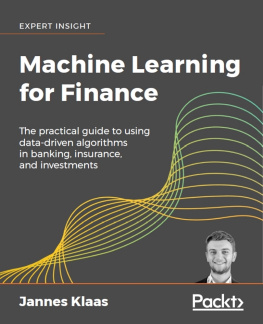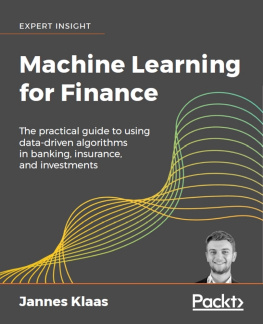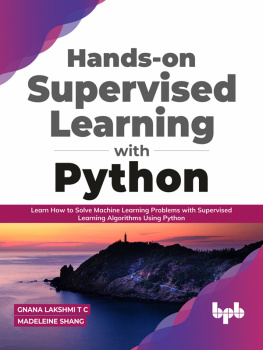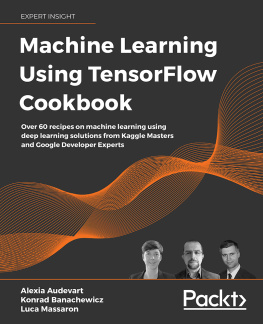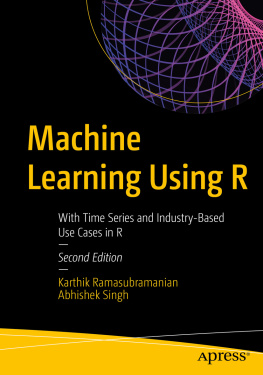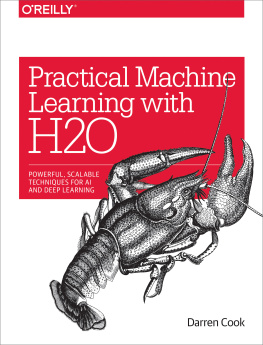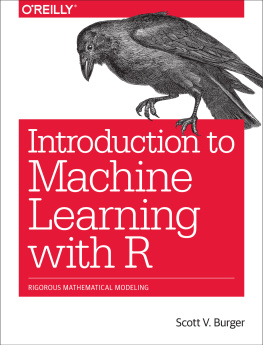Machine Learning for Finance
Copyright 2019 Packt Publishing
All rights reserved. No part of this book may be reproduced, stored in a retrieval system, or transmitted in any form or by any means, without the prior written permission of the publisher, except in the case of brief quotations embedded in critical articles or reviews.
Every effort has been made in the preparation of this book to ensure the accuracy of the information presented. However, the information contained in this book is sold without warranty, either express or implied. Neither the author, nor Packt Publishing or its dealers and distributors, will be held liable for any damages caused or alleged to have been caused directly or indirectly by this book.
Packt Publishing has endeavored to provide trademark information about all of the companies and products mentioned in this book by the appropriate use of capitals. However, Packt Publishing cannot guarantee the accuracy of this information.
Acquisition Editors: Frank Pohlmann, Ben Renow-Clarke
Acquisition Editor Peer Reviews: Suresh Jain
Project Editor: Tom Jacob
Development Editor: Alex Sorrentino
Technical Editor: Gaurav Gavas
Proofreader: Safis Editing
Indexer: Rekha Nair
Graphics: Sandip Tadge, Tom Scaria
Production Coordinator: Sandip Tadge
First published: May 2019
Production reference: 1290519
Published by Packt Publishing Ltd.
Livery Place
35 Livery Street
Birmingham B3 2PB, UK.
ISBN 978-1-78913-636-4
www.packtpub.com
mapt.io
Mapt is an online digital library that gives you full access to over 5,000 books and videos, as well as industry leading tools to help you plan your personal development and advance your career. For more information, please visit our website.
Why subscribe?
- Spend less time learning and more time coding with practical eBooks and Videos from over 4,000 industry professionals
- Learn better with Skill Plans built especially for you
- Get a free eBook or video every month
- Mapt is fully searchable
- Copy and paste, print, and bookmark content
Packt.com
Did you know that Packt offers eBook versions of every book published, with PDF and ePub files available? You can upgrade to the eBook version at www.Packt.com and as a print book customer, you are entitled to a discount on the eBook copy. Get in touch with us at customercare@packtpub.com for more details.
At www.Packt.com, you can also read a collection of free technical articles, sign up for a range of free newsletters, and receive exclusive discounts and offers on Packt books and eBooks.
Contributors
About the author
Jannes Klaas is a quantitative researcher with a background in economics and finance. Currently a graduate student at Oxford University, he previously led two machine learning bootcamps and worked with several financial companies on data-driven applications and trading strategies.
His active research interests include systemic risk as well as large-scale automated knowledge discovery.
About the reviewer
James Le is currently a master's student studying computer science at Rochester Institute of Technology. He is pursuing a research path in computer vision using deep learning. On the side, he is an active freelance data scientist and data journalist, with specialties including machine/deep learning, recommendation systems, and data analysis/visualization.
Preface
Aided by the availability of vast amounts of data computing resources, machine learning ( ML ) has made big strides. The financial industry, which at its heart is an information processing enterprise, holds an enormous amount of opportunity for the deployment of these new technologies.
This book is a practical guide to modern ML applied in the financial industry. Using a code-first approach, it will teach you how the most useful ML algorithms work, and how to use them to solve real-world problems
Who this book is for
There are three kinds of people who would benefit the most from this book:
- Data scientists who want to break into finance and would like to know about the spectrum of possible applications and relevant problems
- Developers in any FinTech business or quantitative finance professionals who look to upgrade their skill set and want to incorporate advanced ML methods into their modeling process
- Students who would like to prepare themselves for the labor market and learn some practical skills valued by employers
This book assumes you have some working knowledge in linear algebra, statistics, probability theory, and calculus. However, you do not have to be an expert in any of those topics.
To follow the code examples, you should be comfortable with Python and the most common data science libraries, such as pandas, NumPy, and Matplotlib. The book's example code is presented in Jupyter Notebooks.
Explicit knowledge of finance is not required.
What this book covers
, Neural Networks and Gradient-Based Optimization , will explore what kinds of ML there are, and the motivations for using them in different areas of the financial industry. We will then learn how neural networks work and build one from scratch.
, Applying Machine Learning to Structured Data , will deal with data that resides in a fixed field within, for example, a relational database. We will walk through the process of model creation: from forming a heuristic, to building a simple model on engineered features, to a fully learned solution. On the way, we will learn about how to evaluate our models with scikit-learn, how to train tree-based methods such as random forests, and how to use Keras to build a neural network for this task.
, UtilizingComputer Vision , describes how computer vision allows us to perceive and interpret the real world at scale. In this chapter, we will learn the mechanisms with which computers can learn to identify image content. We will learn about convolutional neural networks and the Keras building blocks we need to design and train state-of-the-art computer vision models.
, Understanding Time Series , looks at the large number of tools devoted to the analysis of temporally related data. In this chapter, we will first discuss the "greatest hits" that industry professionals have been using to model time series and how to use them efficiently with Python. We will then discover how modern ML algorithms can find patterns in time series and how they are complemented by classic methods.
, Parsing Textual Data with Natural Language Processing , uses the spaCy library and a large corpus of news to discuss how common tasks such as named entity recognition and sentiment analysis can be performed quickly and efficiently. We will then learn how we can use Keras to build our own custom language models. The chapter introduces the Keras functional API, which allows us to build much more complex models that can, for instance, translate between languages.
, Using Generative Models

